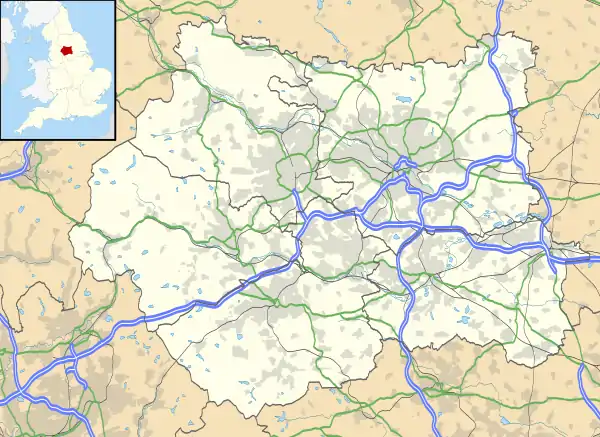Stanbury
Stanbury is a village in the Haworth, Cross Roads and Stanbury civil parish, and in the metropolitan borough of the City of Bradford in West Yorkshire, England. The name Stanbury translates as Stone Fort from Old English.[1]
| Stanbury | |
|---|---|
 Entry to Main Street, Stanbury | |
 Stanbury Location within West Yorkshire | |
| OS grid reference | SE010370 |
| • London | 180 mi (290 km) SSE |
| Civil parish |
|
| Metropolitan borough | |
| Metropolitan county | |
| Region | |
| Country | England |
| Sovereign state | United Kingdom |
| Post town | KEIGHLEY |
| Postcode district | BD22 |
| Police | West Yorkshire |
| Fire | West Yorkshire |
| Ambulance | Yorkshire |
| UK Parliament | |
Geography
The village is situated approximately 1 mile (1.6 km) west from Haworth, 4 miles (6.4 km) south-west from Keighley,[2] and 7 miles (11 km) east from Colne in Lancashire.[3] Less than half a mile north-east is the hamlet of Lumbfoot. Stanbury is Historically part of the West Riding of Yorkshire. The River Worth is immediately north of the village and Sladen Beck is just to the south. Two paths pass through the village; The Brontë Way[4] and The Pennine way.[5]
Landmarks
The surrounding countryside is mainly moors and farmland.[6] Ponden Reservoir was built in the 1870s[7] and a reservoir was approved to be built at Lower Laithe on Sladen Beck in 1869, but it was not started until 1911. Due to the nation being involved in the First World War, the reservoir was not completed until 1925. Its completion necessitated the abandonment of the hamlet of Smith Bank.[8] The village is close to the Brontë Waterfall and Top Withens tourist landmarks. Emily Brontë is reputed to have used Top Withens as the model for the location of Wuthering Heights, and nearby Ponden Hall (half a mile from the edge of Stanbury) has been considered the model for 'Thrushcross Grange' in the same book.[9] It has also been theorized that Ponden Hall is actually the setting for Top Withens as its size is smaller than that of Thrushcross Grange as described in the book.[10][11] There are also additional theories that the hall is the model for Wildfell Hall in Anne Brontë's The Tenant of Wildfell Hall.[12] There is an Anglican church in Stanbury built in 1848. In 1998, it was named St Gabriels, after spending the previous 150 years without a name.[13] The school caters for primary school age children. There are two public houses: The Friendly and the Wuthering Heights which dates from 1763 and was formerly and locally known as 'The Cross'. The Old Silent Inn (formerly The Eagle) is a public house and guest house close to the village which is over 400 years old.[14]
Gallery
 Main Street. Quaker Burial Ground.
Main Street. Quaker Burial Ground..jpg.webp) Main Street, Wuthering Heights PH.
Main Street, Wuthering Heights PH..jpg.webp) Main Street, St.Gabriel's Church.
Main Street, St.Gabriel's Church..jpg.webp) Main Street, former Methodist Chapel.
Main Street, former Methodist Chapel.
References
- Ekwall, Eilert (1960). The Concise Oxford Dictionary of English Place-names (4 ed.). Oxford: Clarendon Press. p. 437. OCLC 400936.
- "104" (Map). Leeds & Bradford. 1:50,000. Landranger. Ordnance Survey. 2016. ISBN 978-0-319-26202-3.
- "103" (Map). Blackburn & Burnley (C2 ed.). 1:50,000. Landranger. Ordnance Survey. 2006. ISBN 978-0-319-22829-6.
- "Brontë Country: The Brontë Way". Brontë Country. Retrieved 17 October 2016.
- "Route Description & Downloads The Pennine way". National Trails. Retrieved 17 October 2016.
- "Stanbury". Yorkshire Guide. Retrieved 17 October 2016.
- Wood, Steven (2011). "Introduction". Haworth, Oxenhope & Stanbury from old photographs. Volume 2, Trade & industry. Stroud: Amberley. p. vi. ISBN 9781445606699.
- "Stanbury Conservation Area Assessment" (PDF). Bradford Council. Bradford Council. October 2005. p. 11. Retrieved 17 October 2016.
- Booth, Alison (2016). "3. Ladies with pets and flowers; with graveyards and windswept moors". Homes and haunts; touring writers' shrines and countries. Oxford: Oxford University Press. p. 139. ISBN 978-0-19-107689-3.
- Butterfield, Mary A (1976). The Heatons of Ponden Hall and the legendary link with Thrushcross Grange in Emily Brontë's Wuthering Heights. Keighley: R & B Taylor. pp. 1–23. OCLC 4932423.
- Somerville, Christopher (28 February 2005). "Yorkshire: Walk of the month". The Telegraph. Travel. Retrieved 17 October 2016.
- Hyslop, Leah (19 June 2013). "For sale: Ponden Hall, the house which inspired Wuthering Heights". The Telegraph. Retrieved 17 October 2016.
- "Stanbury Conservation Area Assessment" (PDF). Bradford Council. Bradford Council. October 2005. p. 23. Retrieved 17 October 2016.
- Knights, David (18 July 2015). "Friendly welcome at the Friendly - as well as Stanbury's other two pubs". Keighley News. Retrieved 17 October 2016.
External links
 Media related to Stanbury at Wikimedia Commons
Media related to Stanbury at Wikimedia Commons- Haworth, Cross Roads and Stanbury Parish Council